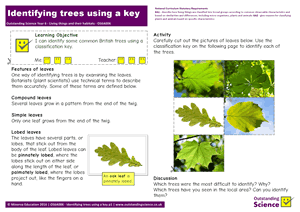

I can use taxonomy to explain how organisms are related to each other.
Children learn that evolutionary taxonomy is the most modern way of grouping organisms. They learn that it is a development of Linnaeus' system, but is superior because it shows how closely organisms are related to each other. Children group 5 mammals (including homo sapiens) into an evolutionary diagram. They use this to explain how closely related the other 4 mammals are to modern humans. They work out the binomial (genus-species) name for each organism.
I can make a dichotomous key and use it to classify organisms.
Children use the 6 pictures of animals provided to create their own dichotomous classification key. Children discuss why some classification questions are better than others.

2 pages
I can explain how Linnaeus developed a classification system.
Children sort 20 different objects into Linnaeus' kingdoms. They discuss the elements from Linnaeus's system that we still use, those that we have abandoned, and why.

3 pages
I can classify animals as vertebrates and invertebrates.
Children identify 18 organisms as vertebrates or invertebrates and place them in the correct sub-group (fish, birds, mammals, amphibians, reptiles, insects, arachnids, molluscs, worms).

3 pages
I can identify familiar arthropods using a classification key.
Children use a dichotomous classification key to identify 10 different arthropods. They discuss why arthropods have certain body features in common.

3 pages
I can identify some common British trees using a classification key.
Children look at the leaves of 5 different trees common to the British isles and identify them using a dichotomous key. They discuss which of these trees they have seen in the local area.

2 pages
I can identify invertebrates in the local environment.
Children choose 4 different local micro-habitats to investigate. They predict and then observe which types of invertebrate they might find in each micro-habitat, using the arthropod identification key provided. Children record their results in a table and then transfer their results to a bar chart. They discuss which micro-habitat is most diverse in terms of invertebrate population.

3 pages
I can identify trees in the local environment.
Children choose an area in the local environment to study. Using the tree classification key provided, children complete a tally chart showing the frequency of each type of tree in the local area. They transfer their results to a bar chart.

3 pages
I can classify organisms as micro-organisms and explain what they are.
Pupils learn why micro-organisms are classified as such and explore some of their basic features. Using the writing frame and diagrams provided, they create an information text or poster to apply their learning.

2 pages